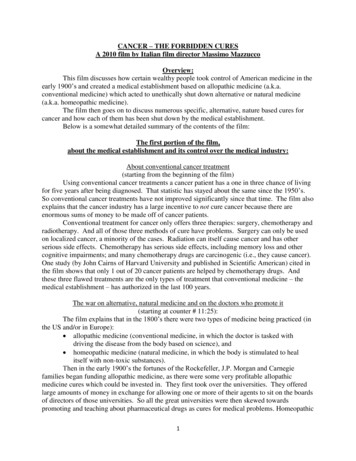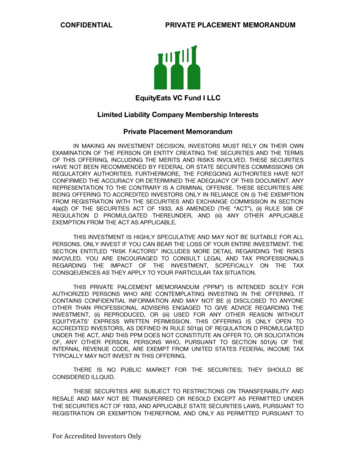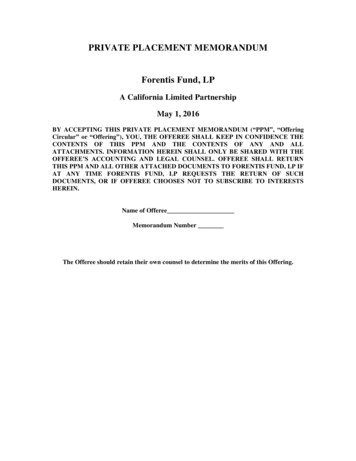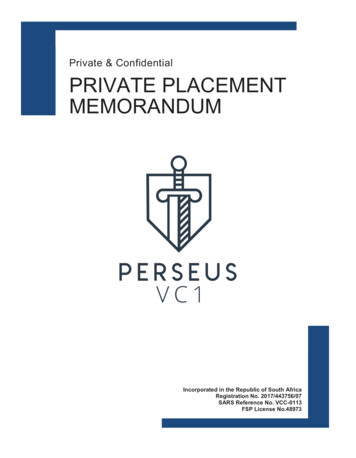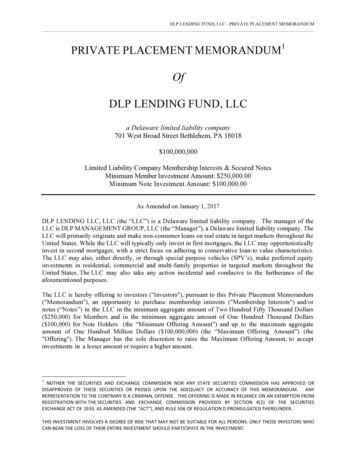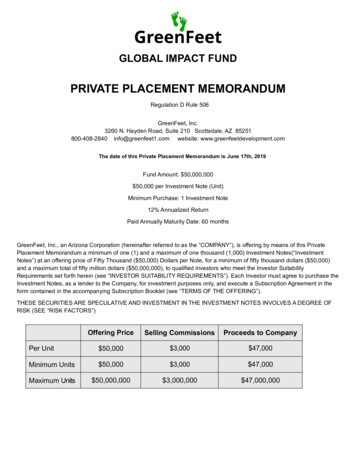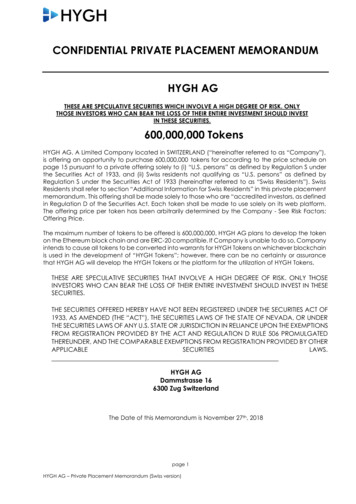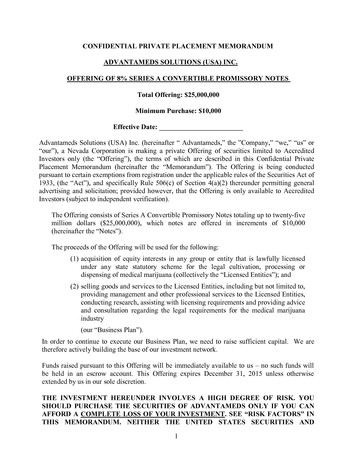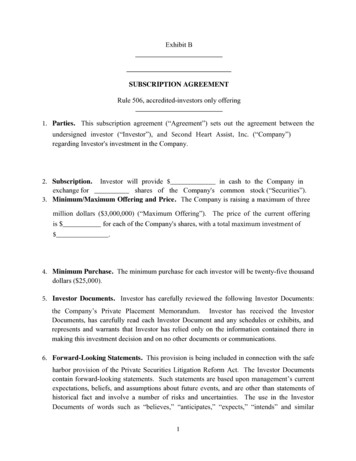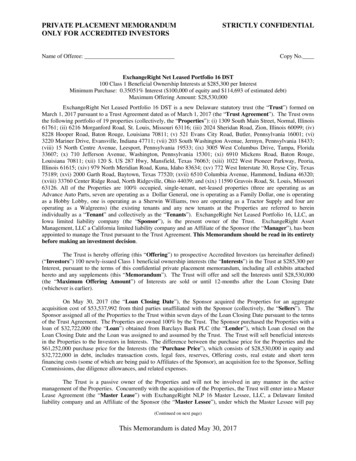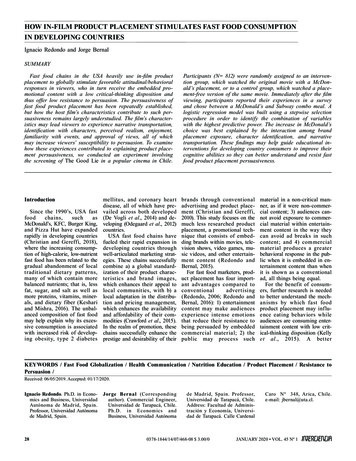
Transcription
HOW IN-FILM PRODUCT PLACEMENT STIMULATES FAST FOOD CONSUMPTIONIN DEVELOPING COUNTRIESIgnacio Redondo and Jorge BernalSUMMARYFast food chains in the USA heavily use in-film productplacement to globally stimulate favorable attitudinal/behavioralresponses in viewers, who in turn receive the embedded promotional content with a low critical-thinking disposition andthus offer low resistance to persuasion. The persuasiveness offast food product placement has been repeatedly established,but how the host film’s characteristics contribute to such persuasiveness remains largely understudied. The film’s characteristics may lead viewers to experience narrative transportation,identification with characters, perceived realism, enjoyment,familiarity with events, and approval of views, all of whichmay increase viewers’ susceptibility to persuasion. To examinehow these experiences contributed to explaining product placement persuasiveness, we conducted an experiment involvingthe screening of The Good Lie in a popular cinema in Chile.IntroductionSince the 1990’s, USA fastfoodchains,suchasMcDonald’s, KFC, Burger King,and Pizza Hut have expandedrapidly in developing countries(Christian and Gereffi, 2018),where the increasing consumption of high-calorie, low-nutrientfast food has been related to thegradual abandonment of localtraditional dietar y patter ns,many of which contain morebalanced nutrients; that is, lessfat, sugar, and salt as well asmore proteins, vitamins, minerals, and dietary fiber (Keshariand Mishra, 2016). The unbalanced composition of fast foodmay help explain why its excessive consumption is associatedwith increased risk of developing obesity, type 2 diabetesmellitus, and coronary heartdisease, all of which have prevailed across both developed(De Vogli et al., 2014) and developing (Odegaard et al., 2012)countries.USA fast food chains havefueled their rapid expansion indeveloping countries throughwell-articulated marketing strategies. These chains successfullycombine a) a global standardization of their product characteristics and brand images,which enhances their appeal tolocal communities, with b) alocal adaptation in the distribution and pricing management,which enhances the availabilityand affordability of their commodities (Crawford et al., 2015).In the realm of promotion, thesechains successfully enhance theprestige and desirability of theirParticipants (N 812) were randomly assigned to an intervention group, which watched the original movie with a McDonald’s placement, or to a control group, which watched a placement-free version of the same movie. Immediately after the filmviewing, participants reported their experiences in a surveyand chose between a McDonald’s and Subway combo meal. Alogistic regression model was built using a stepwise selectionprocedure in order to identify the combination of variableswith the highest predictive power. The increase in McDonald’schoice was best explained by the interaction among brandplacement exposure, character identification, and narrativetransportation. These findings may help guide educational interventions for developing country consumers to improve theircognitive abilities so they can better understand and resist fastfood product placement persuasiveness.brands through conventionaladvertising and product placement (Christian and Gereffi,2010). This study focuses on themuch less researched productplacement, a promotional technique that consists of embedding brands within movies, television shows, video games, music videos, and other entertainment content (Redondo andBernal, 2015).For fast food marketers, product placement has four important advantages compared toconventionaladver tising(Redondo, 2006; Redondo andBernal, 2016): 1) entertainmentcontent may make audiencesexperience intense emotionsthat reduce their resistance tobeing persuaded by embeddedcommercial material; 2) thepublic may process suchmaterial in a non-critical manner, as if it were non-commercial content; 3) audiences cannot avoid exposure to commercial material within entertainment content in the way theycan avoid ad breaks in suchcontent; and 4) commercialmaterial produces a greaterbehavioral response in the public when it is embedded in entertainment content than whenit is shown as a conventionalad, all things being equal.For the benefit of consumers, further research is neededto better understand the mechanisms by which fast foodproduct placement may influence eating behaviors whileaudiences are consuming entertainment content with low critical-thinking disposition (Kellyet al., 2015). A betterKEYWORDS / Fast Food Globalization / Health Communication / Nutrition Education / Product Placement / Resistance toPersuasion /Received: 06/05/2019. Accepted: 01/17/2020.Ignacio Redondo. Ph.D. in Economics and Business, UniversidadAutónoma de Madrid, Spain.Professor, Universidad Autónomade Madrid, Spain.28Jorge Bernal (Cor respondi ngauthor). Commercial Engineer,Universidad de Tarapacá, Chile.Ph.D. i n Economics andBusiness, Universidad Autónomade Madrid, Spain. Professor,Universidad de Tarapacá, Chile.Address: Facultad de Administración y Economía, Universidad de Tarapacá. Calle Cardenal0378-1844/14/07/468-08 3.00/0Caro N 348, Arica, Chile.e-mail: jbernal@uta.cl.JANUARY 2020 VOL. 45 Nº 1
CÓMO LOS EMPLAZAMIENTOS CINEMATOGRÁFICOS ESTIMULAN EL CONSUMO DE COMIDA RÁPIDAEN PAÍSES EN DESARROLLOIgnacio Redondo y Jorge BernalRESUMENLas cadenas estadounidenses de comida rápida son mostradas en películas para promover globalmente respuestas favorables de un público que está expuesto con escaso sentido críticoy poca prevención ante la persuasión. La capacidad persuasivade estos emplazamientos cinematográficos ha sido repetidamente contrastada pero apenas se conoce cómo esa capacidad estácondicionada por las características de la película correspondiente. Estas características pueden facilitar que los espectadores se identifiquen con los personajes, viajen al mundo narrado,perciban realismo, se diviertan, conozcan los hechos representados y aprueben las opiniones manifestadas, todo lo cual puede aumentar la susceptibilidad a la persuasión. Para medir lacontribución de estos factores, hicimos un experimento basadoen la proyección de The Good Lie en un cine popular de Chile.Los participantes (N 812) fueron asignados aleatoriamente aun grupo de experimentación, que vio la película original conun emplazamiento de McDonald’s, y un grupo control, que viouna versión de la misma película sin emplazamiento. Despuésla película, los participantes manifestaron sus experienciasen una encuesta y eligieron entre un menú de McDonald’s oSubway. Mediante un modelo de regresión logística se identificóla combinación de factores con mayor poder predictivo. El incremento en la elección de McDonald’s fue mejor explicado porla interacción entre la exposición al emplazamiento, la identificación con los personajes y el viaje al mundo narrado. Estosresultados podrían orientar acciones educativas dirigidas a quelos consumidores de países en desarrollo puedan comprender yresistir mejor los emplazamientos de comida rápida.COMO O MERCHANDISING CINEMATOGRÁFICO ESTIMULA O CONSUMO DE COMIDA RÁPIDA EM PAÍSESEM DESENVOLVIMENTOIgnacio Redondo e Jorge BernalRESUMOAs cadeias americanas de fast-food são mostradas em filmespara promover globalmente respostas favoráveis de um públicoque está exposto com escasso sentido crítico e pouca prevençãodiante da persuasão. A capacidade persuasiva do merchandising cinematográfico tem sido repetidamente contrastada, masapenas se conhece como essa capacidade está condicionadapelas características do filme correspondente. Estas características podem facilitar aos espectadores identificar-se comos personagens, viajar ao mundo narrado, perceber realismo,divertir-se, conhecer fatos representados e aprovar as opiniões manifestadas, todo o qual pode aumentar a suscetibilidadeà persuasão. Para medir a contribuição destes fatores, realizamos um experimento baseado na projeção de The Good Lieem um cinema popular do Chile. Os participantes (N 812) fo-ram designados aleatoriamente a um grupo de experimentação,que viu o filme original com o merchandising de McDonald’s,e um grupo controle, que viu uma outra versão do mesmo filme sem a veiculação do produto. Após o filme, os participantesmanifestaram suas experiências em uma enquete e escolheramlanches em menus de McDonald’s ou Subway. Mediante ummodelo de regressão logística se identificou a combinação defatores com maior poder preditivo. O incremento na seleção deMcDonald’s foi melhor explicado pela interação entre a exposição ao merchandising, a identificação com os personagens e aviagem ao mundo narrado. Estes resultados poderiam orientarações educativas orientadas para que os consumidores de países em desenvolvimento possam compreender e resistir melhoro merchandising de comida rápida.understanding of such mechanisms would help teach defense skills against productplacement so that consumersa) gain awareness of how theycan be gently persuaded, b)understand which psychological processes make them moresusceptible to persuasion, andc) improve their cog nitiveabilities to resist attempts topersuade (Har r is et al.,2009b). It is particularly important to study such mechanisms among developing country consumers because individuals with lower socioeconomic stat us are moreplacements is relatively high. Ina sample of 200 popular films(the top 20 USA box officemovie hits for each year from1996 to 2005), 203 fast foodbrand placements were identified, among which 43 corresponded to McDonald’s, 23 toBurger King, 19 to DunkinDonuts, and 19 to Starbucks(Sutherland et al., 2010). Withrespect to the mode of representation, fast food consumption is often portrayed unrealistically as an aspirational activity that intelligent/popular/attractive characters perform in predominantly pleasant situationsvulnerable to misinterpretationof food portrayals in entertainment content (Vermeerschand Swenerton, 1980; Avery etal., 1997) and because susceptibility to persuasion is greateramong those developing count r y consu mers who have agreater admiration for developed world lifestyles (Batra etal., 2000). It is also appropriate to cover all age groupsbecause susceptibility to persuasion has been found amongboth minors and adults (Harriset al., 2009a).Focusing on film content, theprevalence of fast food productJANUARY 2020 VOL. 45 Nº 1(Story and Faulkner, 1990) andas an eating pattern with nopotential negative consequencesforconsumers’health(Greenberg et al., 2009). Notsurprisingly, the more consumers are exposed to these fastfood portrayals, the more likelythey will bias their views of thepotential health consequences offast food consumption (Russelland Buhrau, 2015).Previous studies have consistently found that in-film foodbrand placement has an immediate effect on viewers’ brandchoices, and also found that thesize of such an effect increases29
depending on certain characteristics of the promotional stimulus: A greater proportion ofviewers is persuaded when thebrand is shown more frequently/extensively in the film (Matthesand Naderer, 2015; Brown etal., 2017), when the film’s characters interact with the brand(Naderer et al., 2018), when thenegative effects of the brand’sconsumption are not shown(Redondo, 2012), and when thebrand’s placement is accompanied by conventional advertisingof the brand during commercialbreaks (Uribe and FuentesGarcía, 2015). By contrast,there is a substantial researchgap regarding the role playedby the characteristics of thefilm in which the promotionalstimulus is embedded. As explained subsequently, experienced reactions to film characteristics may affect those viewerpsychological mechanismsthrough which the embeddedpromotional content persuades.Investigating the role of filmcharacteristicsThe consistent persuasiveness of in-film product placement can be understood byconsidering that film contenttends to automatically producestory-consistent attitudinal/behavioral changes in viewersthrough a mechanism based onsocial cognitive theory, whichstates that humans vicariouslylearn attitudinal/behavioral responses by mere observation ofthe attitudes/behaviors modeledin entertainment and news media(Bandura,1986).Specifically, this theory helpsexplain why branded food/drinkportrayals in film stories automatically shape viewers’ eating/drinking responses to the promoted brands (Greenberg et al.,2009; Redondo et al., 2018).The automatic persuasiveness of product placement maybe enhanced when the characteristics of the sur roundingfilm content make viewers experience narrative transportation, identification with characters, perceived realism, andfeeling of enjoyment.A film’s narrative may leadviewers to experience a mental30transportation into the worldevoked by the story, an experience generally known as narrative transportation (Green andBrock, 2000). This psychological process may reduce viewers’ motivation and ability tothink critically about the story’s content, thus making themmore susceptible to persuasion(Dal Cin et al., 2004).Film characters may movethe public to experience psychological identification withthem, which typically manifests as feeling intimacy withthem, engaging in theirthoughts and emotions, viewing them as role models, andimitating their attitudes/behaviors (Cohen, 2001; Russell andStern, 2006). The more viewersidentify with characters, theless critically they analyze thereasons and consequences ofsuch characters’ attitudes/behaviors (Slater, 2002).Perception of a film realism(i.e., that its actions, events,settings, and characters areconsistent with each other; DalCin et al., 2004) may helpviewers maintain their emotional involvement in the story(Busselle and Bilandzic, 2008)and enable them to vicariouslylearn and subsequently adoptstory-consistent attitudes/behaviors (Bandura, 2001).Film enjoyment may resultin a positive emotional state inwhich viewers are less likel
28.02.2020 · and Pizza Hut have expanded rapidly in developing countries (Christian and Gereffi, 2018), where the increasing consump-tion of high-calorie, low-nutrient fast food has been related to the gradual abandonment of local traditional dietary patterns, many of which contain more balanced nutrients; that is, less fat, sugar, and salt as well as more proteins, vitamins, miner-als, and dietary fiber .
